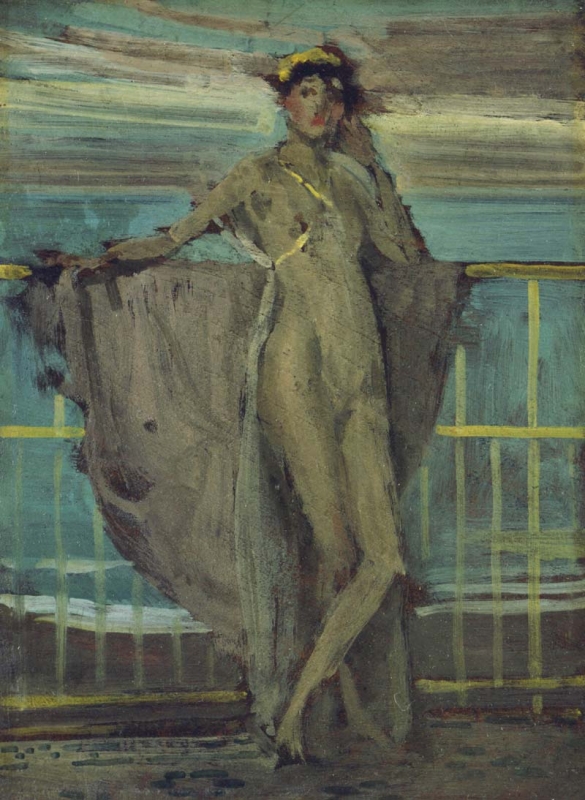Titles
Whistler's original title is not known. This has become known by only one title:
The title is based on the similarity of the composition to that of Annabel Lee [YMSM 079], which itself was not necessarily so named by Whistler. It may have been a 'Sketch for' that painting or a reworking of the pose and subject.
These titles, now generally accepted, derive from a poem by Edgar Allan Poe (1809-1849), who, like Whistler, was a (failed) West Point man. 3 Whistler's long-standing enthusiasm for Poe's writing was shared by his friends in Paris in the 1890s, and in particular by the symbolist poet Stéphane Mallarmé (1842-1898) and his circle. In 1889 Mallarmé presented Whistler with a copy of his translation of Les Poèmes d'Edgar Poe, including 'Annabel Lee'. Mallarmé's translation, which could have inspired Whistler to return to the subject, is as follows:
'Il y a mainte et mainte année, dans un royaume près de la mer, vivait une jeune fille, que vous pouvez connaître par son nom d’Annabel Lee, et cette jeune fille ne vivait avec aucune autre pensée que d’aimer et d’être aimée de moi.
J’étais un enfant, et elle était un enfant, dans ce royaume près de la mer ; mais nous nous aimions d’un amour qui était plus que de l’amour, - moi et mon Annabel Lee ; d’un amour que les séraphins ailés des Cieux convoitaient à elle et à moi.
Et ce fut la raison qu’il y a longtemps, — un vent souffla d’un nuage, glaçant ma belle Annabel Lee ; de sorte que ses proches de haute lignée vinrent et me l’enlevèrent, pour l’enfermer dans un sépulcre, en ce royaume près de la mer.
Les anges, pas à moitié si heureux aux cieux, vinrent, nous enviant, elle et moi. Oui ! ce fut la raison (comme tous les hommes le savent dans ce royaume près de la mer) pourquoi le vent sortit du nuage la nuit, glaçant et tuant mon Annabel Lee.
Car la lune jamais ne rayonne sans m’apporter des songes de la belle Annabel Lee ; et les étoiles jamais ne se lèvent que je ne sente les yeux brillants de la belle Annabel Lee ; et ainsi, toute l’heure de nuit, je repose à côté de ma chérie, — de ma chérie, — ma vie et mon épouse, dans ce sépulcre près de la mer, dans sa tombe près de la bruyante mer.
Mais, pour notre amour, il était plus fort de tout un monde que l’amour de ceux plus âgés que nous ; — de plusieurs de tout un monde plus sages que nous, — et ni les anges là-haut dans les cieux, — ni les démons sous la mer, ne peuvent jamais disjoindre mon âme de l’âme de la très belle Annabel Lee.' 4
Description
A figure study in vertical format. A young woman stands in front of a railing, with her arms extended on the rail at either side. She faces the viewer, her head slightly tilted. Her weight rests on her left leg, and her left leg crosses over in front of it. She wears a diaphanous close-fitting robe tied across the breast with yellow ribbon. A dull pinkish/mauve cloak hangs on the railing. She has a bright yellow ribbon in her short hair. She is standing on a white carpet with a woven blue pattern. Behind the railing is the pale blue sea and a cloudy sky streaked with pale blue, cream and grey. The railing is yellow, with a rectangular grid of rails.
Sitter
Unknown.
Notes:
1: Young, A. McLaren, James McNeill Whistler, Arts Council Gallery, London, and Knoedler Galleries, New York, 1960 (cat. no. 21).
2: YMSM 1980 [more] , cat. no. 80.
3: Kobbé, Gustave, 'Whistler at West Point,' The Chap Book, vol. 8, no. 11, 15 April 1898, pp. 439-42.
4: Les Poèmes d'Edgar Poe (Brussels 1888). Inscribed copy, GUL Whistler; poem ed. Griswold, Willis & Lowell.
Last updated: 20th October 2020 by Margaret






